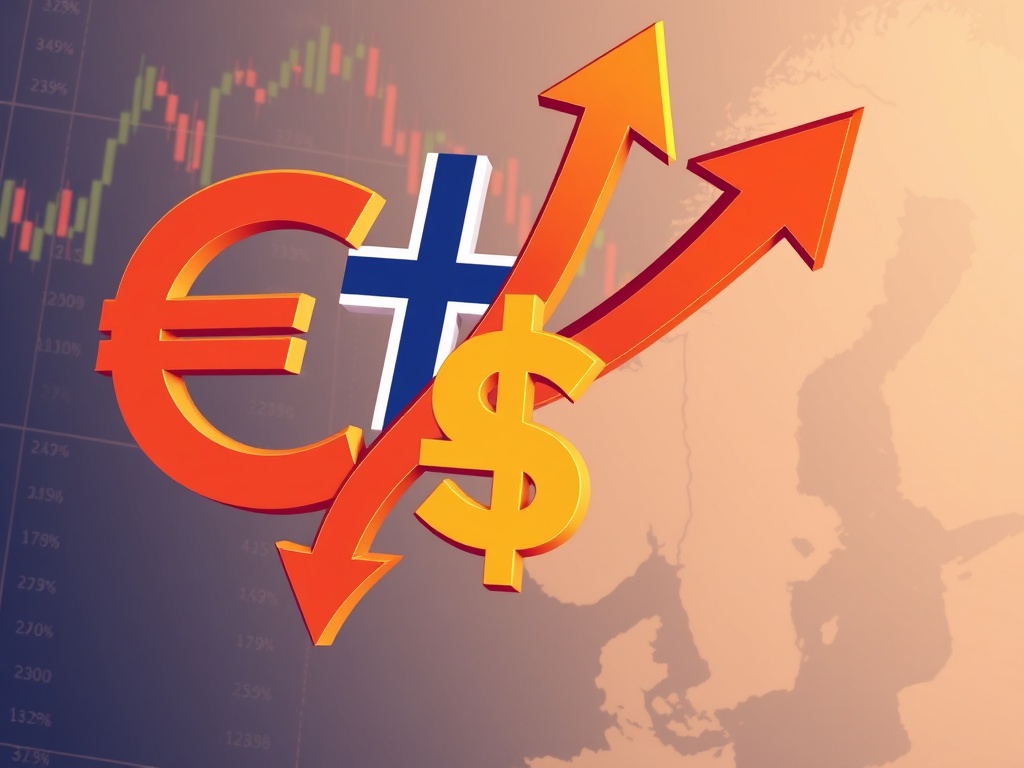BitcoinWorld

Nordic FX Forecasts: UBS Unveils Surprising Shifts for EUR/NOK and EUR/SEK
While the cryptocurrency market often captures headlines with its rapid shifts and groundbreaking innovations, the traditional foreign exchange (FX) market remains a bedrock of global finance, influencing everything from international trade to investment returns. For savvy investors and market watchers, understanding the nuanced movements in currency pairs is crucial. Recently, a significant development has emerged from UBS, a major player in global finance, regarding its outlook on the Nordic FX Forecasts, specifically for the EUR/NOK and EUR/SEK currency pairs. These adjustments are not just technical shifts; they reflect deeper economic currents and strategic recalibrations that could have substantial implications for anyone with exposure to European and Scandinavian assets.
Understanding the Latest Nordic FX Forecasts from UBS
UBS, a financial powerhouse renowned for its insightful market analysis, has recently recalibrated its projections for key Nordic currency pairs: the Euro against the Norwegian Krone (EUR/NOK) and the Euro against the Swedish Krona (EUR/SEK). These revised Nordic FX Forecasts are more than mere numerical adjustments; they represent a considered response to evolving macroeconomic landscapes, central bank policies, and global market dynamics. For investors, these shifts from a major institution like UBS can often signal broader market sentiment and potential future trends, making them essential reading for anyone engaged in the FX space.
What exactly are these shifts, and why do they matter? In essence, UBS has taken a more nuanced view of the Norwegian and Swedish economies. While specific numbers are not provided here, the general direction indicates a more optimistic outlook for the Norwegian Krone (NOK) and a more cautious stance on the Swedish Krona (SEK) against the Euro. This divergence highlights the differing economic trajectories and policy responses within the Nordic region. The implications extend beyond just currency traders, affecting multinational corporations, exporters, importers, and even individuals planning travel or investments in these regions.
Key aspects of these revised forecasts often revolve around:
- Central Bank Policy Divergence: The differing stances of the Norges Bank (Norway’s central bank) and the Riksbank (Sweden’s central bank) on interest rates and inflation targeting.
- Economic Resilience: The relative strength and resilience of the Norwegian economy, often bolstered by commodity prices, versus the challenges faced by the Swedish economy, particularly in its housing sector and manufacturing.
- Inflationary Pressures: How inflation is evolving in each country and the central banks’ responses to bring it back to target.
- Global Risk Appetite: How broader global economic sentiment and risk-on/risk-off dynamics influence smaller, open economies like Norway and Sweden.
Diving Deeper into the EUR NOK Exchange Rate Dynamics
The EUR NOK Exchange Rate has been a focal point for many analysts, and UBS’s updated outlook suggests a more favorable trajectory for the Norwegian Krone. Historically, the NOK is often considered a commodity currency, heavily influenced by oil prices given Norway’s status as a major oil and gas producer. However, the current narrative extends beyond just energy markets.
Several factors contribute to the revised outlook for the EUR/NOK:
- Norges Bank’s Hawkish Stance: The Norges Bank has demonstrated a more proactive approach to combating inflation, maintaining a relatively higher interest rate compared to the European Central Bank (ECB). This interest rate differential makes the NOK more attractive to yield-seeking investors.
- Robust Economic Performance: Despite global headwinds, the Norwegian economy has shown signs of resilience. Strong labor market data, contained inflation (compared to some other European nations), and a stable fiscal position provide a solid foundation for the currency.
- Oil Price Stability: While not the sole driver, a stable or rising oil price environment provides a supportive backdrop for the NOK, boosting export revenues and government coffers.
- Reduced Global Uncertainty: A calmer global economic outlook can reduce demand for safe-haven currencies, allowing commodity-linked currencies like the NOK to perform better.
For those tracking the EUR NOK Exchange Rate, the shift from UBS implies that the Krone may be undervalued or that its fundamental strengths are becoming more apparent. This could translate into a stronger NOK against the Euro in the coming months, presenting potential opportunities for investors looking to diversify their portfolios or capitalize on currency movements.
Analyzing the Outlook for the EUR SEK Exchange Rate
In stark contrast to its Norwegian counterpart, the EUR SEK Exchange Rate has seen a less optimistic revision from UBS. The Swedish Krona has faced a challenging period, grappling with a confluence of domestic and international pressures. This revised outlook reflects a more cautious assessment of Sweden’s economic prospects and the Riksbank’s policy challenges.
What are the key headwinds impacting the SEK?
- Riksbank’s Policy Dilemma: The Riksbank has been navigating a complex environment, balancing high inflation with concerns about a weakening economy and a fragile housing market. While they have hiked rates, the market’s perception of their resolve or effectiveness in taming inflation without triggering a deeper recession has sometimes been questioned.
- Housing Market Vulnerabilities: Sweden’s highly indebted household sector and a cooling property market pose significant risks. A sharp downturn in housing could dampen consumer spending and investment, weighing on overall economic growth.
- Manufacturing Sector Weakness: Sweden’s export-oriented manufacturing sector has been sensitive to global demand fluctuations and supply chain disruptions, contributing to economic slowdown concerns.
- Inflation Persistence: Despite Riksbank efforts, inflation has proven stubborn in certain sectors, leading to expectations of a longer period of tight monetary policy, which can in turn stifle growth.
The revised outlook for the EUR SEK Exchange Rate suggests that the Swedish Krona may continue to face depreciation pressures against the Euro. This could make Swedish exports more competitive but also increase the cost of imports, potentially exacerbating inflationary pressures. Investors need to be particularly vigilant when considering exposure to SEK-denominated assets, as currency depreciation can erode returns.
Key Drivers Behind UBS’s Currency Strategy Adjustments
UBS’s comprehensive Currency Strategy adjustments for the Nordic region are not arbitrary. They are meticulously formulated based on a deep dive into several interconnected macroeconomic factors. Understanding these drivers is essential for any investor seeking to replicate or anticipate such strategic shifts in the FX market.
Here are the primary pillars underpinning UBS’s revised outlook:
- Divergent Monetary Policy Paths: This is arguably the most significant factor. The Norges Bank has been more assertive in its tightening cycle, driven by robust domestic demand and higher-than-expected inflation. Conversely, while the Riksbank has also hiked rates, market participants often perceive its stance as less aggressive or more constrained by domestic vulnerabilities like the housing market. The widening interest rate differential between Norway and the Eurozone (and the relatively smaller or more uncertain differential with Sweden) directly impacts currency attractiveness.
- Inflation Trajectories and Expectations: Both countries are battling inflation, but the pace and persistence differ. Norway’s inflation, while elevated, has shown signs of peaking, allowing the Norges Bank more flexibility. Sweden’s inflation, particularly core inflation, has proven more stubborn, leading to concerns about a prolonged period of high rates or a deeper economic slowdown if rates are pushed too high. UBS’s Currency Strategy considers how these inflation paths will influence future central bank actions.
- Economic Growth Differentials: The Norwegian economy has demonstrated greater resilience, partly due to its strong energy sector and robust public finances. Sweden, on the other hand, faces a more challenging growth outlook, weighed down by its highly leveraged household sector, a cooling property market, and a sensitive manufacturing sector. A stronger growth outlook typically supports a currency, while a weaker outlook tends to exert downward pressure.
- Global Risk Sentiment and Capital Flows: In times of global uncertainty, investors often flock to safe-haven currencies, which are typically major currencies like the USD, EUR, or JPY. Smaller, more open economies like Norway and Sweden are more susceptible to shifts in global risk appetite. If global sentiment improves, the NOK, as a commodity-linked currency, might benefit from increased risk-taking. Conversely, a deterioration in global sentiment could disproportionately impact the SEK due to its perceived vulnerabilities.
- Terms of Trade: For Norway, rising commodity prices (especially oil and gas) significantly improve its terms of trade, meaning its exports are more valuable relative to its imports. This provides a fundamental boost to the NOK. Sweden, lacking significant commodity exports, does not benefit from this tailwind to the same extent, making its currency more reliant on manufacturing exports and domestic demand.
These intricate interdependencies form the basis of a sophisticated Currency Strategy, highlighting that FX movements are rarely driven by a single factor but rather a complex interplay of macroeconomic forces.
Implications for Investors in Scandinavian Krona
For investors navigating the complex world of foreign exchange, UBS’s revised outlook for the Scandinavian Krona offers crucial insights. These shifts are not merely academic; they translate into tangible opportunities and risks for various investment strategies, from portfolio diversification to tactical trading.
What are the key implications?
For Norwegian Krone (NOK) Exposure:
- Potential for Appreciation: The more positive outlook for NOK suggests it could be an attractive currency for investors seeking appreciation against the Euro. This might involve buying NOK-denominated assets or directly holding NOK against the EUR.
- Yield Advantage: Given the Norges Bank’s higher interest rates, holding NOK can offer a yield advantage over EUR, making it appealing for carry trades, where investors borrow in a low-interest currency and invest in a high-interest one.
- Commodity Linkage: While broader economic factors are at play, the NOK’s correlation with oil prices means investors should also monitor global energy markets. A strong oil market generally provides a supportive backdrop for the NOK.
- Diversification: Including NOK in a diversified currency portfolio can offer exposure to a resilient, commodity-rich economy, potentially balancing out other exposures.
For Swedish Krona (SEK) Exposure:
- Continued Weakness Risk: The cautious outlook for SEK implies a higher risk of further depreciation against the Euro. Investors with SEK-denominated assets should be mindful of potential currency-related losses that could erode returns.
- Monitoring Domestic Vulnerabilities: Close attention should be paid to Sweden’s housing market, household debt levels, and the Riksbank’s response to persistent inflation. These domestic factors will heavily influence the SEK’s trajectory.
- Cautious Approach to Yield: While the Riksbank has hiked rates, the overall economic picture and perceived policy constraints might limit the SEK’s attractiveness for yield-seeking strategies compared to NOK.
- Export Competitiveness: A weaker SEK could benefit Swedish exporters by making their goods cheaper abroad, but it also increases the cost of imports and could contribute to inflation.
Actionable Insights for Investors:
- Monitor Central Bank Communication: Pay close attention to statements from the Norges Bank, Riksbank, and ECB. Their forward guidance on interest rates and economic outlook will be critical.
- Track Economic Data: Keep an eye on inflation reports, GDP figures, employment data, and housing market statistics for both Norway and Sweden.
- Assess Global Risk Appetite: Understand how broader market sentiment (risk-on vs. risk-off) impacts these smaller, open economies.
- Consider Hedging Strategies: For businesses or investors with significant exposure to either Scandinavian Krona, implementing hedging strategies might be prudent to mitigate currency risk.
- Consult with Financial Advisors: Always seek professional advice tailored to your specific financial situation and risk tolerance before making investment decisions based on these forecasts.
In essence, UBS’s updated perspective serves as a powerful reminder that not all “Krona” are created equal. A nuanced approach, distinguishing between the fundamental drivers of the Norwegian and Swedish currencies, is paramount for successful navigation of the Nordic FX landscape.
Navigating the Volatility: A Strategic Approach to Nordic Currencies
The dynamic nature of the foreign exchange market, as exemplified by UBS’s recent adjustments to its Nordic currency forecasts, underscores the importance of a strategic and adaptive approach for investors. It highlights that while broad regional trends might exist, individual country-specific factors—from central bank mandates to unique economic vulnerabilities—can lead to significant divergence in currency performance. For those with exposure to EUR/NOK or EUR/SEK, this means moving beyond a generalized “Nordic” view and embracing a more granular analysis.
The insights from UBS serve as a valuable benchmark, prompting market participants to re-evaluate their positions and assumptions. Whether it’s the Norges Bank’s assertive stance supporting the Krone or the Riksbank’s challenging balancing act impacting the Swedish Krona, these central bank narratives are critical. Furthermore, the interplay of global commodity prices, inflation trajectories, and overall economic resilience paints a complex but discernible picture for each currency pair. Investors who proactively integrate these factors into their decision-making process are better positioned to mitigate risks and capitalize on emerging opportunities.
Conclusion: Staying Ahead in the Dynamic FX Market
UBS’s revised Nordic FX Forecasts for EUR/NOK and EUR/SEK provide a compelling narrative of divergence within the Scandinavian currency bloc. While the Norwegian Krone appears to be gaining favor due to a hawkish central bank and resilient economy, the Swedish Krona faces persistent headwinds from inflation and housing market vulnerabilities. For investors, understanding these nuanced differences and the underlying economic drivers is paramount. The foreign exchange market is a constantly evolving landscape, and staying informed through expert analysis, diligent data monitoring, and a flexible Currency Strategy is key to navigating its complexities successfully. The insights offered by institutions like UBS are invaluable guides in this journey, helping market participants make more informed decisions in a world where every pip counts.
To learn more about the latest Forex market trends, explore our article on key developments shaping the Euro, Norwegian Krone, and Swedish Krona liquidity and institutional adoption.
This post Nordic FX Forecasts: UBS Unveils Surprising Shifts for EUR/NOK and EUR/SEK first appeared on BitcoinWorld and is written by Editorial Team





